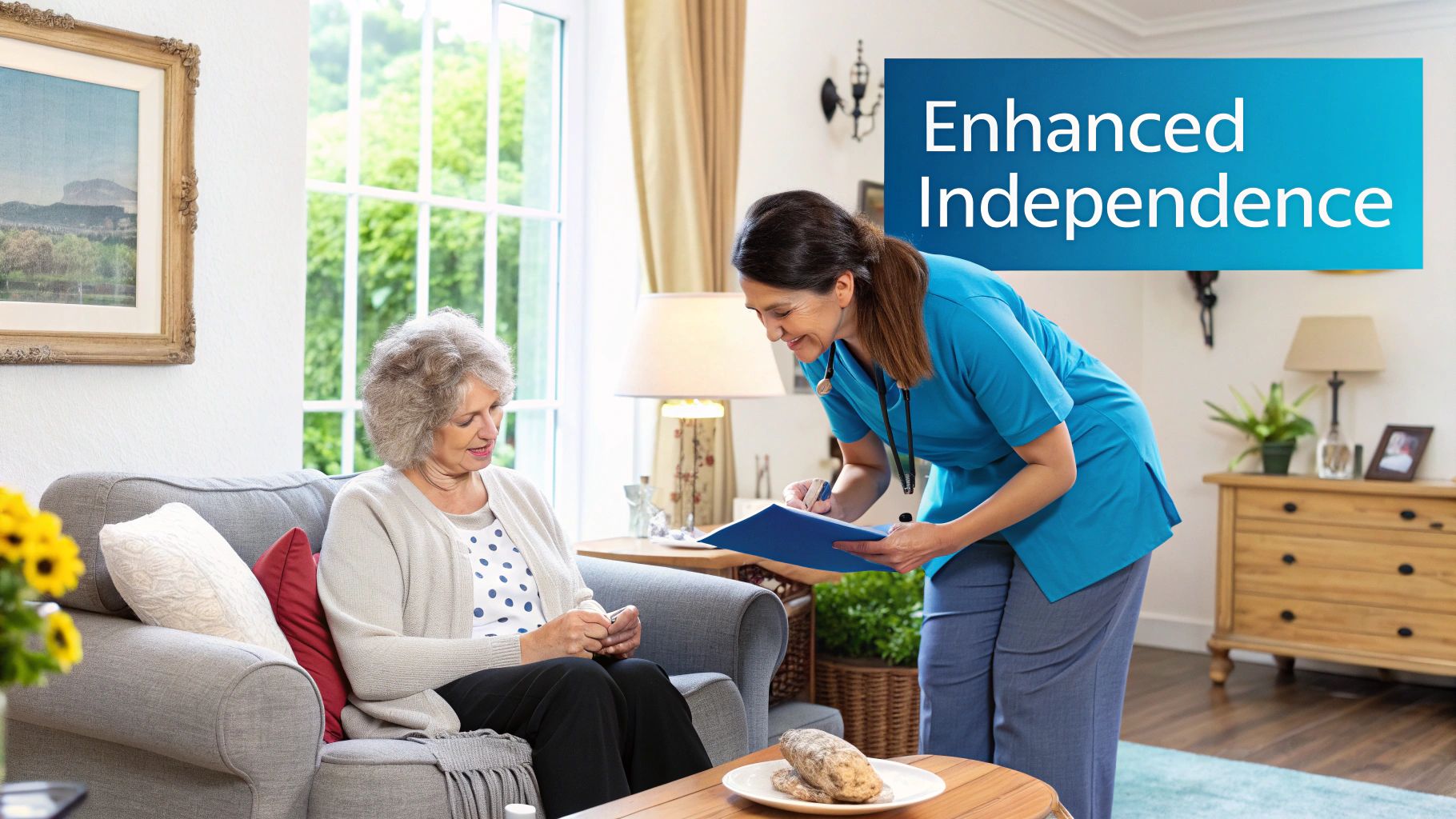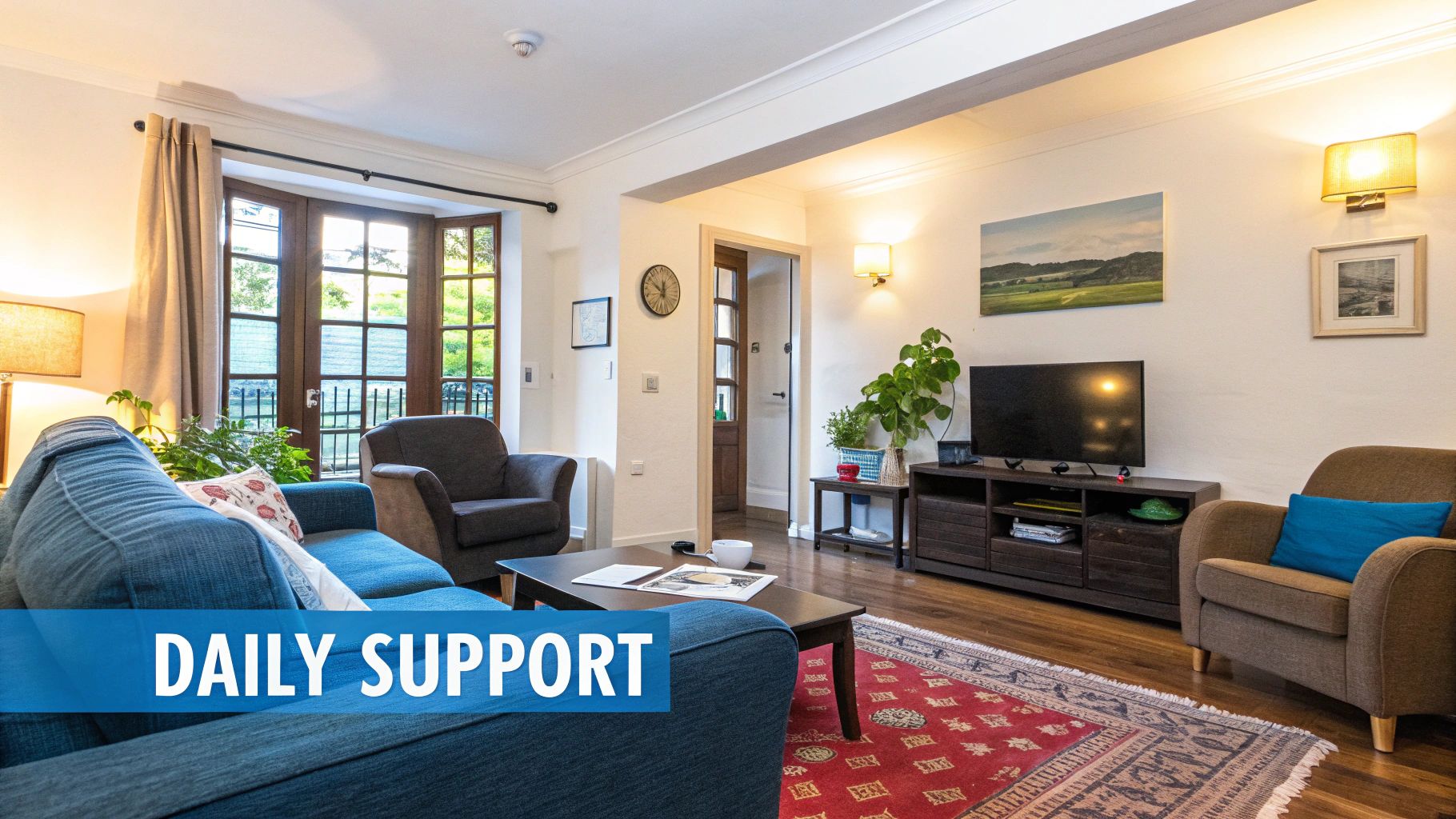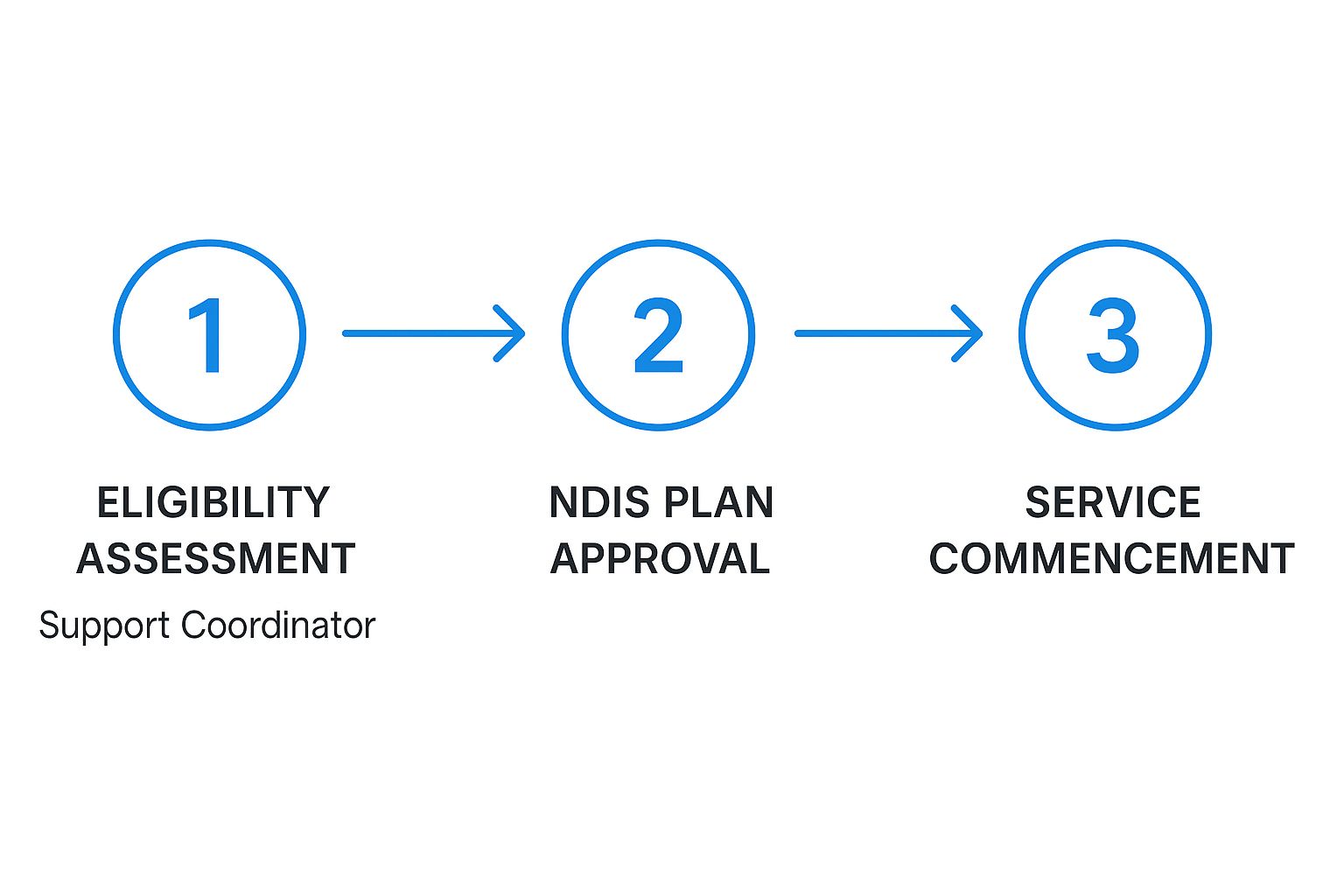Supported Independent Living Adelaide | Your Guide to Greater Independence

Picture this: you have your own place, your own rules, but with a friendly support crew on hand to help you tackle daily life and build your confidence. That’s the heart of Supported Independent Living (SIL) in Adelaide. It’s a dedicated NDIS support designed to help you live more independently, right in your own home.
What is Supported Independent Living, Really?
In short, SIL is all about having people to help you with day-to-day tasks. It's for NDIS participants who need a bit of help throughout the day, whether they live on their own or with housemates. It's not about doing things for you, but doing them with you, so you can build real-world skills.
I like to think of it like having a personal coach for your home life. Your coach doesn't run the race for you, but they're there on the sidelines, offering guidance, support, and just the right amount of help to make sure you can cross the finish line yourself. That's what SIL support workers do—they provide the tailored assistance you need to achieve your own goals.
This kind of support can look different for everyone, but it often includes things like:
- Help with personal care routines, like getting showered and dressed.
- A hand with household jobs, from cleaning to doing the laundry.
- Support in the kitchen with planning meals and cooking.
- Guidance on practical skills like managing a household budget.
- Reminders and assistance to take medication correctly.
The Key Difference: SIL vs. SDA
It's easy to get SIL mixed up with another NDIS term, Specialist Disability Accommodation (SDA). But they are two very different things, and it's vital to know how they differ.
Think of it this way: SIL is the support from people—the support workers who help you with daily tasks. SDA, on the other hand, is the physical house—the specially designed building you live in if you have very high support needs.
You might have SIL funding for support in your family home, a regular rental apartment, or even in an SDA property. The NDIS funds them separately because they serve different purposes. One covers the human support you need, while the other covers the specialised bricks and mortar.
To see how this works in practice, it can be helpful to explore more about understanding Vana Care’s SIL services in South Australia. Getting this distinction right is the first step in creating a home environment in Adelaide that truly empowers you on your journey to greater independence.
What Are the Real-World Benefits of SIL in Adelaide?

Stepping into a Supported Independent Living arrangement in Adelaide isn't just about finding a new place to live. It's about opening a door to personal growth and a new sense of freedom. The benefits ripple through every part of your life, creating a foundation for a richer, more connected future. Think of it as building the life you want to lead, with a safety net of support tailored to help you thrive.
At its heart, SIL is all about genuine independence. You're in the driver's seat, making your own choices about your daily schedule, how you want your home to feel, and all the little things that make a day your own. This feeling of control is a powerful boost for self-esteem and confidence.
Building Life Skills That Actually Stick
One of the best things about a SIL setup is the focus on learning practical skills you'll use every day. This isn't a classroom lecture; it's hands-on learning, with someone right there to guide you whenever you need it.
This kind of skill-building is absolutely vital for long-term independence. Across the country, SIL has become a critical support for over 28,000 Australians, and Adelaide is no exception, with fantastic providers ready to meet a wide range of needs. It's a proven model, especially considering that around 60% of SIL participants live with significant physical or intellectual disabilities, empowering them to live as independently as possible. If you want to dive deeper, you can learn the secrets to selecting a great SIL provider and see how much of a difference the right choice makes.
With the right people by your side, you can confidently master skills like:
- Money Smarts: Learning to create and manage a budget for groceries, bills, and fun.
- Running Your Home: Getting the hang of cooking your favourite meals, keeping the place tidy, and handling basic maintenance.
- Connecting with Others: Building great relationships with your housemates and feeling more confident engaging with your local community.
A Better Quality of Life and Stronger Community Ties
When you have a stable, supportive home, you finally have the headspace to focus on what truly matters to you. With the day-to-day support taken care of, you have more energy to explore your passions and build meaningful friendships.
This is the real magic of Supported Independent Living: moving beyond just getting through the day to actively building a life you love. It’s about being an engaged, active member of your Adelaide community.
Maybe this means joining a local sports team, picking up a new hobby you've always been curious about, or even finding a volunteer role. Sometimes, the most powerful motivation comes from seeing how others have made it work. You can read some of our inspiring client success stories from Vana Care to see what's possible.
Ultimately, SIL is about giving you the tools to create a fulfilling life, completely on your own terms.
How NDIS Funding for SIL Works

Let's be honest, figuring out the money side of Supported Independent Living can feel overwhelming. But it doesn't have to be. The NDIS has specific funding for SIL because it recognises that some people need a significant, ongoing level of help to live on their own terms. It's a major commitment from the NDIS, often covering round-the-clock personal support.
To get this funding, you first need to be an NDIS participant with a clear goal in your plan about living more independently. The next step is showing the NDIS why you need this level of support. This usually involves a functional capacity assessment from an occupational therapist, which spells out your daily needs. The NDIS just needs to see that SIL is a "reasonable and necessary" step for you to reach your goals.
What SIL Funding Actually Covers
So, what does the NDIS money pay for? This is where people often get tangled up.
A simple way to think about it is that SIL funding pays for the people who support you—the support workers who are there to help with daily life.
That support can look like:
- Help with personal care, like showering and dressing.
- Assistance with cooking meals, cleaning, and keeping the house in order.
- Support to manage your medications correctly and safely.
- Building your skills in everyday tasks like budgeting and grocery shopping.
- Having someone on hand to ensure you're safe at home.
The NDIS calculates this funding based on a document called a Roster of Care (ROC). It’s essentially a detailed schedule that breaks down how many hours of support you need each day and what kind of support it is, whether that's active overnight help or shared support with your housemates.
What SIL Funding Does Not Cover
It's just as crucial to know what isn't covered. These are the everyday living costs that everyone has, whether they have a disability or not.
Your SIL funding will not pay for:
- Rent: The cost of your room or board is a personal expense.
- Groceries: You'll need to budget for your own food and drinks.
- Utilities: Bills for electricity, water, gas, and the internet are your responsibility.
- Transport: The costs of getting around are funded separately in your NDIS plan.
- Household Goods: Things like furniture, bedding, or kitchen utensils aren't included.
The NDIS draws a clear line: SIL pays for the support you need to live independently, not the cost of living itself. Getting this straight from the start makes budgeting and planning so much easier.
Understanding the Financial Scale of SIL
Because the support is so intensive, SIL funding packages are some of the largest in the NDIS. To give you an idea, the average annual payment for a South Australian participant in SIL was about $387,700 for the year ending 31 December 2022.
This figure varied across the state; for instance, participants in Northern Adelaide received an average of $435,400, while those in the Adelaide Hills averaged around $373,000. These numbers really show the NDIS's commitment to giving people the right support to live full lives.
This level of funding reflects the incredible difference that consistent, person-centred support can make. For a deeper dive into the whole process, take a look at our complete guide on navigating NDIS in Adelaide for disability support.
Your Step-by-Step Guide to the SIL Application
Applying for Supported Independent Living in Adelaide can feel a bit overwhelming at first glance. But when you break it down into a few key stages, the whole process becomes much clearer and far less intimidating. Think of it as building a case for yourself—the goal is to give the NDIS a crystal-clear picture of your support needs.
Laying the Groundwork: The Power of a Good Assessment
Before you even think about application forms, your journey starts with gathering the right evidence. The single most important document you'll need is a comprehensive functional capacity assessment.
This is usually done by an allied health professional, like an occupational therapist. This report is your cornerstone; it’s a professional evaluation that details your day-to-day support needs, your personal goals, and makes a strong case for why SIL is the right kind of support to help you live more independently.
Preparing for Your NDIS Planning Meeting
Once you have that assessment, it’s time to prepare for your NDIS planning meeting. This isn’t just a formal chat; it's your chance to tell your story. You need to clearly explain what you want your life to look like.
Don't just focus on the challenges. Talk about your ambitions. Do you want to learn to cook new recipes? Manage your own weekly budget? Or maybe just feel secure knowing someone is there overnight? Be specific. The clearer you are about your goals, the easier it is for the NDIS to connect the dots and see how SIL funding will help you get there.
This infographic breaks down the journey into three simple phases.

As you can see, a solid assessment is the foundation. It leads to NDIS approval, which then opens the door to starting your services and living more independently.
A good support coordinator is worth their weight in gold during this stage. They are experts at navigating the NDIS and can help you collect all the right documents and present your case effectively. Find out more in our guide on maximising your NDIS plan with support coordination.
Understanding the Roster of Care
Now for a piece of paperwork that sounds more technical than it is: the Roster of Care (ROC). It's essentially a detailed weekly schedule that maps out exactly when and how you'll receive support.
Think of the Roster of Care as the instruction manual for your SIL funding. It translates your support needs into a clear, hour-by-hour plan that the NDIS uses to calculate your budget.
This roster gets very specific, breaking down support into different types:
- Shared Support: This covers time when a support worker is on hand to help both you and your housemates, like during meal preparation or communal activities.
- 1:1 Support: This is time dedicated just to you, for personal care, appointments, or working on individual goals.
- Active Overnight Support: This is for situations where a support worker needs to be awake and available all night long.
A potential provider, such as Vana Care, will work closely with you and your occupational therapist to put together a draft ROC. It's crucial that this schedule is realistic and directly linked to the goals you've outlined in your NDIS plan. By focusing on these steps—gathering strong evidence, preparing well for your meeting, and creating a detailed Roster of Care—you’ll be well on your way to a successful SIL application.
Finding the Right SIL Provider in Adelaide

Choosing a Supported Independent Living provider is one of the most personal and important decisions you’ll make on your NDIS journey. This isn’t just about finding a service; it's about choosing the people who will be part of your daily life and who will champion your move towards greater independence.
Think of it like choosing a housemate. The right fit can make your home a happy, supportive place, while the wrong one can create constant stress. Your SIL provider is a partner in your home, so getting that relationship right is absolutely critical.
What to Look For in a Provider
When you first start looking, the number of providers can feel overwhelming. To cut through the marketing noise, it helps to focus on what really matters for your happiness and success. A good, honest provider in Adelaide will be open about how they work and happy to answer all your questions.
Here’s what you should be looking for:
- A Genuinely Person-Centred Approach: Does their conversation centre on your goals, or do they just list their services? A great provider always starts with you—your needs, your ambitions, and your idea of a good life.
- Qualified and Kind Staff: Ask about their team. What training and qualifications do their support workers have? Just as important, how do they make sure their staff are compassionate, respectful, and a good personality match for the people they support?
- A Solid Local Reputation: Look for a provider with real roots and a strong reputation in the Adelaide community. Don't be afraid to ask for testimonials or see if you can chat with other participants or their families about their experience.
Your relationship with your SIL provider is a partnership. It has to be built on trust. They should listen to you, respect your decisions, and empower you to live life on your own terms.
Key Questions to Ask Potential Providers
Once you've got a shortlist, it's time to get into the details. Never feel shy about asking direct, practical questions. The way a provider responds will tell you everything you need to know about their culture and values.
This is your chance to see how they’d handle real-life situations. For a complete checklist of questions, our guide on choosing the right disability support in Adelaide is a great resource.
To get the ball rolling, here are a few essential questions:
- How do you match housemates? This is a big one. A good provider will have a thoughtful process for bringing people together who have similar interests, communication styles, and support needs.
- What’s your process for dealing with conflict between residents? Let's be real—disagreements happen. You need a provider with a clear, fair, and respectful plan for helping everyone resolve issues.
- Can I meet the actual support workers who would be in my home? Meeting the team is non-negotiable. You need to feel comfortable and safe with the people supporting you every day.
- How much control will I have over my own daily routine? The answer should always be, "as much as you want." A provider's job is to support your choices, not dictate your schedule.
At the end of the day, trust your gut. Visit the homes, meet the staff, and go with the provider that feels like the best partner for you.
Common Questions About SIL in Adelaide
Stepping into the world of Supported Independent Living in Adelaide often brings up a handful of practical questions. Getting straight answers is the first step to feeling in control of your journey. Let's walk through some of the most common queries we hear.
What’s the Difference Between SIL and SDA?
This is easily the most common point of confusion, but it’s quite simple when you break it down.
Think of it this way: SIL funding is for the support people who help you, while Specialist Disability Accommodation (SDA) funding is for the physical house itself.
SIL covers the cost of support workers who assist with daily life inside your home. SDA, on the other hand, is funding for the actual "bricks and mortar"—a specially designed or modified home built for people with very high physical support needs. It's important to know you can have SIL funding without living in an SDA home.
Can I Choose My Housemates in a SIL Home?
Yes, you can, and you absolutely should have the final say. A great SIL experience depends heavily on getting along with the people you live with. Any good SIL provider in Adelaide understands this and will invest time and care into matching you with the right housemates.
A quality provider will have a thoughtful process for this, considering things like:
- Shared interests and hobbies.
- Similar lifestyles and daily routines.
- Comparable support needs and communication styles.
You should always have the chance to meet potential housemates before committing to anything. Don't be shy about asking a provider to explain their matching process—it’s a huge clue about how much they value creating a genuinely happy and supportive home.
What If My Support Needs Change Over Time?
Your NDIS plan and your SIL funding aren't set in stone. They're built to be flexible and evolve right alongside you. If your support needs increase or even decrease, you can always request a plan review.
Your support should always fit your life, not the other way around. A change in your needs is a normal part of the journey, and the NDIS system is built to respond to it.
For a plan review, you'll need to gather current reports and assessments from your allied health team. This paperwork shows the NDIS how your circumstances have changed and why your funding needs to be adjusted. A dedicated SIL provider will work with you on this, helping you track your progress and collect the right evidence so your support always feels just right.
Do I Pay Rent in a SIL Arrangement?
Yes, you do. It’s crucial to be clear on this from the beginning. Your NDIS funding for supported independent living adelaide is specifically for your support services—not for everyday living costs.
You will still be responsible for paying for your own:
- Rent (often called a "reasonable rent contribution").
- Groceries and other household goods.
- Utilities like electricity, gas, and internet.
Usually, the rent contribution is a set percentage of the Disability Support Pension, plus any Commonwealth Rent Assistance you're eligible for. The rising cost of living has certainly had an impact, and recent NDIS data shows it. By late 2024, the average annual SIL plan budget in a region like Eastern Adelaide hit $512,000, with average payments sitting around $472,400—a clear sign of the substantial support being allocated. You can dig deeper into these figures by reading the NDIS SIL funding trends in South Australia. Always make sure you get a clear, written breakdown of all costs from a provider before you sign on the dotted line.
Choosing the right support isn't just about services; it's about finding a team that feels like a true partner. At Vana Care, we build relationships on trust, respect, and a genuine desire to see you achieve your goals. If you're looking for a provider in Adelaide that puts you first, explore how Vana Care can help you on your journey to independence.


